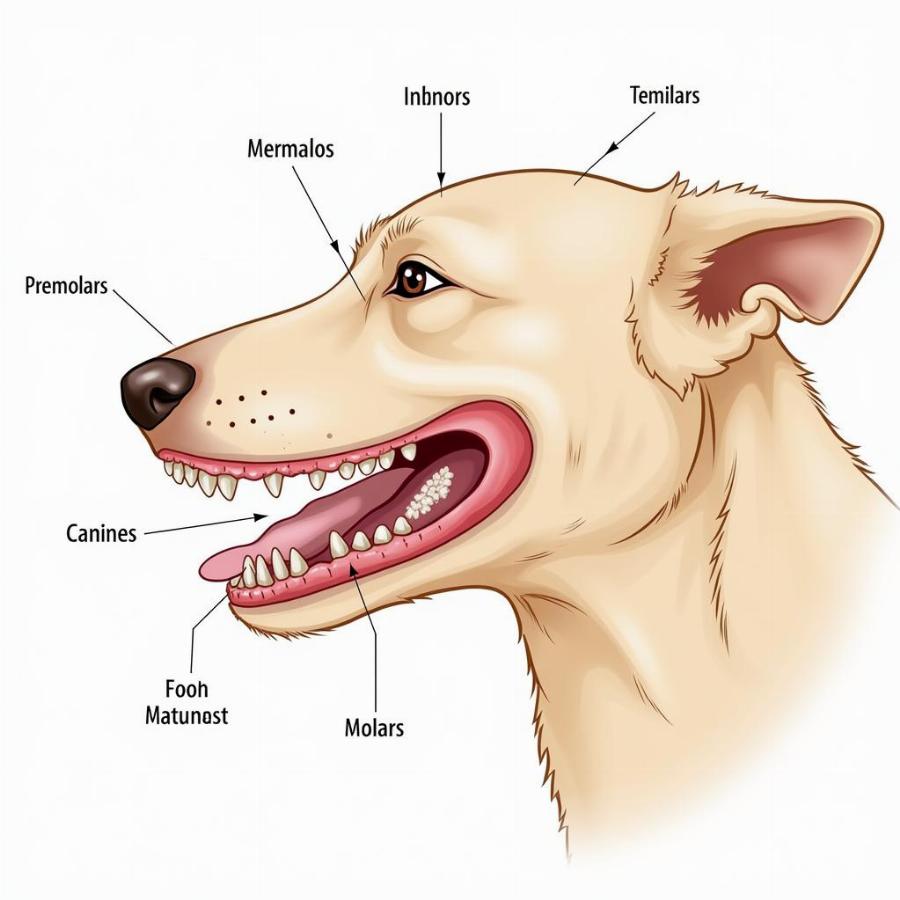A dog dental chart is a valuable tool that helps visualize the arrangement of a dog’s teeth. It’s used by veterinarians and pet owners alike to track dental health, identify potential issues, and understand the progression of dental disease. Just like humans, dogs need regular dental care, and a dental chart provides a roadmap to ensure their pearly whites stay healthy.
Deciphering the Dog Dental Chart
 Dog Dental Chart Anatomy
Dog Dental Chart Anatomy
At first glance, a dog dental chart might look confusing, but it’s quite simple once you understand the basics.
-
Types of Teeth: Dogs have four types of teeth: incisors (for nibbling), canines (for tearing), premolars (for crushing), and molars (for grinding). Each type has a specific location and function.
-
Numbering System: The chart uses a specific numbering system to identify each tooth. The upper right teeth are numbered 101-110, the upper left 201-210, the lower left 301-311, and the lower right 401-411.
-
Puppy vs. Adult Teeth: Puppies have 28 deciduous teeth, also known as baby teeth, which they lose between 14 and 30 weeks of age. Adult dogs have 42 permanent teeth.
Why is a Dog Dental Chart Important?
A dog dental chart plays a crucial role in your furry friend’s overall health:
-
Early Detection: Regular dental checkups using a chart help identify early signs of dental disease, such as plaque buildup, gingivitis, and tooth decay.
-
Tracking Dental Health: The chart allows veterinarians to monitor changes in your dog’s teeth over time, enabling them to intervene promptly if necessary.
-
Treatment Planning: In cases of dental disease, the chart helps determine the appropriate treatment plan, whether it’s a simple cleaning or a more complex procedure.
Common Dental Issues in Dogs
Just like humans, dogs are susceptible to a range of dental problems, including:
-
Plaque and Tartar: Plaque is a sticky film that builds up on teeth. If not removed, it hardens into tartar, which can lead to gum disease.
-
Gingivitis: This is the inflammation of the gums, often caused by plaque and tartar buildup.
-
Periodontal Disease: This serious gum infection can damage the gums and supporting structures of the teeth.
-
Fractured Teeth: Dogs can fracture their teeth while chewing on hard objects or during trauma.
Keeping Your Dog’s Smile Bright
Maintaining good dental hygiene is essential for your dog’s overall health and well-being. Here are some tips:
-
Daily Brushing: Aim to brush your dog’s teeth daily using a dog-specific toothbrush and toothpaste.
-
Dental Chews and Toys: Provide dental chews and toys that help scrape away plaque and tartar.
-
Regular Veterinary Dental Checkups: Schedule professional dental cleanings and checkups with your veterinarian as recommended.
Conclusion
Understanding and utilizing a dog dental chart is an essential part of responsible dog ownership. By familiarizing yourself with the layout of your dog’s teeth and the importance of regular dental care, you can help keep your furry friend’s smile bright and healthy for years to come. Remember, a healthy mouth means a happier dog!
FAQs about Dog Dental Charts
1. What is the best way to brush my dog’s teeth?
Start by getting your dog used to having their mouth touched. Use a dog-specific toothbrush and toothpaste, and focus on the outer surfaces of the teeth in a circular motion.
2. How often should my dog have a professional dental cleaning?
The frequency of professional dental cleanings varies depending on your dog’s breed, age, and overall dental health. Consult your veterinarian for personalized recommendations.
3. Can I use human toothpaste on my dog?
No, human toothpaste contains ingredients that can be harmful to dogs. Always use a toothpaste specifically formulated for dogs.
4. What are the signs of dental problems in dogs?
Bad breath, red or swollen gums, drooling, difficulty chewing, and pawing at the mouth are all potential signs of dental problems.
5. Can dental problems in dogs affect their overall health?
Yes, dental problems can lead to more serious health issues if left untreated. Bacteria from the mouth can enter the bloodstream and affect the heart, liver, and kidneys.
6. Are certain dog breeds more prone to dental problems?
Yes, small breed dogs and those with short noses are generally more susceptible to dental problems.
7. What should I do if I notice a problem with my dog’s teeth?
If you notice any signs of dental problems, schedule an appointment with your veterinarian as soon as possible.
Want to Learn More About Dog Dental Care?
- dog dental chart: Explore our comprehensive guide to understanding dog dental charts and their importance.
- dental charts for dogs: Discover different types of dog dental charts and how they’re used in veterinary practice.
- dog canine dental chart full size printable: Download and print a full-size dog canine dental chart for your reference.
About Beaut Dogs
Beaut Dogs is your one-stop resource for all things related to dog care. We provide expert advice, tips, and resources to help you keep your furry companion happy and healthy. For personalized support and answers to your questions, contact our team at [email protected].